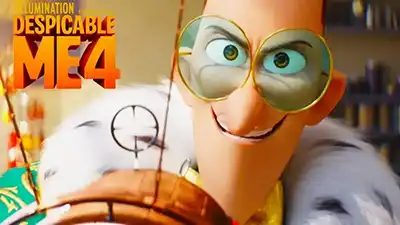Despicable Me 4: A Disappointing Descent into Formulaic Chaos
The Despicable Me franchise, once a beacon of irreverent humor and heartwarming family dynamics, has long relied on the chaotic charm of Gru, his adopted daughters, and the scene-stealing Minions. However, Despicable Me 4 (2024) marks a stark departure from the series’ original magic. Directed by Chris Renaud and co-written by Mike White (Migration), this installment struggles to balance its legacy of wit and subversive storytelling with a formulaic, disjointed narrative that feels more like a corporate checklist than a creative endeavor. While children may still giggle at the Minions’ slapstick antics, longtime fans will find little to celebrate in this overstuffed, tonally confused sequel.
Plot Overview
The film opens with Gru (Steve Carell), now a full-fledged member of the Anti-Villain League, facing a new nemesis: Maxime Le Mal (Will Ferrell), a flamboyant French supervillain-turned-cockroach hybrid seeking revenge. To protect his family, Gru relocates to a suburban safehouse under the alias “The Cunninghams,” dragging along his wife Lucy (Kristen Wiig), their three daughters, and a newborn son, Gru Jr. Meanwhile, the Minions are sidelined into a poorly executed superhero subplot, involving a bumbling government agent (voiced by Pierre Coffin) attempting to weaponize their chaos.
The story fractures into multiple threads: Gru juggles suburban life while being blackmailed by a neighbor’s daughter into stealing a robotic honey badger; Lucy botches her undercover job as a hairdresser; the Minions wreak havoc as “heroes”; and Maxime kidnaps Gru Jr., turning him into a cockroach minion. By the finale, the film collapses under its own weight, resolving conflicts with a rushed, nonsensical musical number in a prison cell.
Thematic and Narrative Shortcomings
1. Identity Crisis: Gru’s Character Assassination
Gru’s evolution from a lovable villain to a domesticated hero was always inevitable, but Despicable Me 4 accelerates this transition into caricature. Gone is the sly, morally ambiguous antihero who once stole the moon; here, Gru is reduced to a neurotic, risk-averse dad, scrambling to blend into suburbia. His decision to flee from Maxime—a far cry from the bold schemer of earlier films—feels jarringly out of character.
The film’s attempt to inject “relatability” by portraying Gru as socially awkward and overly cautious strips him of his edge. Even his signature deadpan humor feels diluted, replaced by generic dad jokes. As one critic noted, “Gru’s transformation from villain to hero isn’t just complete—it’s boring”.
2. Minions: From Stars to Sidekicks
The Minions, once the franchise’s comedic backbone, are relegated to a forgettable B-plot. Their superhero arc—a lazy parody of X-Men—fails to capitalize on their anarchic charm. Instead of clever physical comedy, their scenes rely on repetitive gags (e.g., getting stuck in vending machines, accidentally attacking civilians). Even their signature gibberish feels phoned in.
Worse, their reduced screen time highlights the film’s lack of originality. As one viewer lamented, “The Minions’ antics used to feel spontaneous. Now, it’s like watching a factory assembly line of banana jokes”.

3. A Messy, Contrived Story
Despicable Me 4 suffers from narrative bloat. Subplots pile up without cohesion:
- Gru’s Suburban Farce: His forced interactions with neighbors and a nonsensical honey badger heist add little to the central conflict.
- Lucy’s Hair Salon Disaster: A subplot about Lucy accidentally scalping a client plays as mean-spirited rather than funny, undermining her previously sharp, capable character.
- Gru Jr.’s Underdeveloped Arc: The baby’s transformation into a cockroach lacks emotional stakes, and his eventual “Dada” moment feels unearned.
The film’s pacing is equally erratic, veering between slapstick chaos and saccharine family moments without tonal consistency. Critics have compared its structure to “a golden retriever in a Petco plushie aisle”—distracted and directionless.
4. Villain Fatigue
Maxime Le Mal, despite Ferrell’s energetic performance, is a forgettable antagonist. His cockroach gimmick—a literal and metaphorical pest—fails to evoke the menace of Vector (Despicable Me) or the complexity of Balthazar Bratt (Despicable Me 3). His motivation (revenge for a vague past humiliation) feels lazy, and his defeat is anticlimactic.
Audience and Critical Reception
The film has polarized viewers. On Showtimes.com, it holds a middling 3.59/5 based on 54 votes, with parents praising its “silly fun” while adults criticized its “lack of substance”2. Metacritic’s mixed score (28% positive, 67% mixed) reflects similar divides:
- Positive Reviews: Highlight the Minions’ “random lunacy” and Steve Carell’s “lovable grump” persona.
- Negative Reviews: Lambast the “overstuffed plot” and “lack of narrative focus,” calling it “the weakest in the series”.
In China, critics were harsher, panning the “illogical, cobbled-together script” and “lazy creativity”3. Meanwhile, promotional articles on Sohu.com touted the film’s “heartwarming family themes,” though these claims ring hollow given the film’s execution.
Despicable Me 4 epitomizes the pitfalls of franchise fatigue. By prioritizing marketability over creativity, Illumination Entertainment has diluted what once made this series special: its ability to blend subversive humor with genuine heart. While toddlers may still revel in the Minions’ pratfalls, older audiences will mourn the loss of Gru’s roguish charm and the series’ original wit.
As the credits roll on this chaotic, forgettable sequel, one can’t help but wonder: Has the Despicable Me franchise finally run out of ideas? With Minions 3 and Despicable Me 5 already announced, the answer, unfortunately, seems to be “no”.